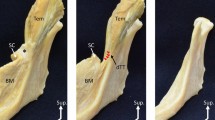Abstract
The authors carried out an anatomic and magnetic resonance imaging study of the architecture of the elevator muscles of the mandible in 169 cadavers. The aim of this study was to define the architectural organization of the human masseter muscle, temporalis and pterygoid muscles. Layered dissections and anatomic sections in different spatial planes showed that the masseter muscle exhibited a typical pennate structure consisting of a succession of alternating musculoaponeurotic layers. The muscle had three well-differentiated parts the superficial, intermediate and deep masseter muscles. The same pattern was constantly found 1) for the superficial masseter, two alternate musculoaponeurotic layers oriented at 60∘ in relation to the plane of occlusion, 2) for the intermediate masseter, a single musculo-aponeurotic layer oriented at 90∘ in relation to the occlusal plane, 3) for the deep masseter, three musculoaponeurotic layers whose general orientation was at 90∘ for the bounding layers and 110∘ for the intermediate layer. The MRI study confirmed the reality of this architectural arrangement.
Similar content being viewed by others
Author information
Authors and Affiliations
Rights and permissions
About this article
Cite this article
Gaudy, JF., Zouaoui, A., Bravetti, P. et al. Functional organization of the human masseter muscle. Surg Radiol Anat 22, 181–190 (2000). https://doi.org/10.1007/s00276-000-0181-5
Received:
Accepted:
Issue Date:
DOI: https://doi.org/10.1007/s00276-000-0181-5




